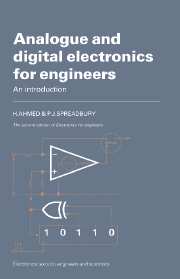Book contents
- Frontmatter
- Contents
- Preface to the second edition
- Preface to the first edition
- 1 Principles of amplifiers
- 2 The p–n junction and the field-effect transistor
- 3 The bipolar transistor
- 4 Operational amplifiers and linear integrated circuits
- 5 Negative feedback
- 6 Positive feedback and oscillators
- 7 Digital fundamentals
- 8 Digital circuits and applications
- Appendix A A list of useful textbooks
- Appendix B Device data and characteristics
- Answers to problems
- Index
3 - The bipolar transistor
Published online by Cambridge University Press: 05 June 2012
- Frontmatter
- Contents
- Preface to the second edition
- Preface to the first edition
- 1 Principles of amplifiers
- 2 The p–n junction and the field-effect transistor
- 3 The bipolar transistor
- 4 Operational amplifiers and linear integrated circuits
- 5 Negative feedback
- 6 Positive feedback and oscillators
- 7 Digital fundamentals
- 8 Digital circuits and applications
- Appendix A A list of useful textbooks
- Appendix B Device data and characteristics
- Answers to problems
- Index
Summary
Introduction
Although a semiconductor amplifier using a field-effect phenomenon was postulated by Shockley in 1952, it was not successfully made until 1963. A bipolar transistor was devised and made by Brattain and Bardeen in 1948: it has developed from almost individually made devices which were sealed in glass envelopes like little valves to the mass produced, robust, cheap devices that we know today. Many of the present integrated circuits, described in chapter 4, use bipolar transistors as their active elements whether they be switches or amplifiers. Some integrated circuit designs using the field-effect transistor are also available but their higher cost must be offset by definite requirements for low noise or very high input resistance. A more detailed comparison of bipolar with field effect transistors is made in §3.16.
The bipolar transistor is used in the power amplifiers of our domestic sound equipment, in the largest computers, and in the most complex integrated circuits. This chapter describes first the principle of operation of the bipolar transistor and its typical characteristics. Then §§3.6 on will describe its use in simple amplifier circuits and discuss problems such as its biasing, stability of operating point, likely gain and frequency response. Lastly some more advanced circuits are considered and a numerical example is worked through.
Principle of operation
Consider the n–p–n sandwich of semiconductor shown in fig. 3.1 (a). This contains two back-to-back p–n junctions; see §§2.1 to 2.4 if you are not familiar with p- and n-type materials, junctions, leakage currents, etc.
- Type
- Chapter
- Information
- Analogue and Digital Electronics for EngineersAn Introduction, pp. 76 - 113Publisher: Cambridge University PressPrint publication year: 1984

